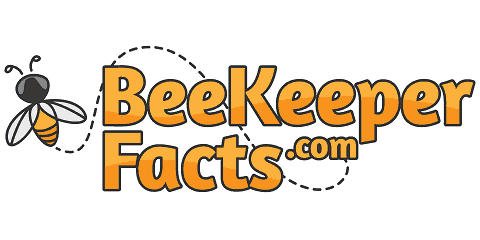How Long Does It Take Honeybees To Make Honey?
Honeybees really are amazing and versatile creatures. It still surprises me how a colony of tiny insects can produce so much honey and beeswax in such a short period of time. But how long does it take for bees to make honey?
It takes approximately 550 bees 2-3 weeks to produce one pound or 454 grams of honey. It takes 2-3 days for a strong colony of bees to fill a 10-frame honey super with honey during a strong nectar flow. A weaker colony may take 1-2 weeks to produce the same amount of honey.
The amount of time a honeybee colony takes to produce honey is subject to many factors such as: the strength of the colony, weather conditions, level of mites, and the time of year. These are just a few of the factors discussed in this post that influence how quickly or slowly bees can produce honey.
How Long Do Bees Take To Produce Honey
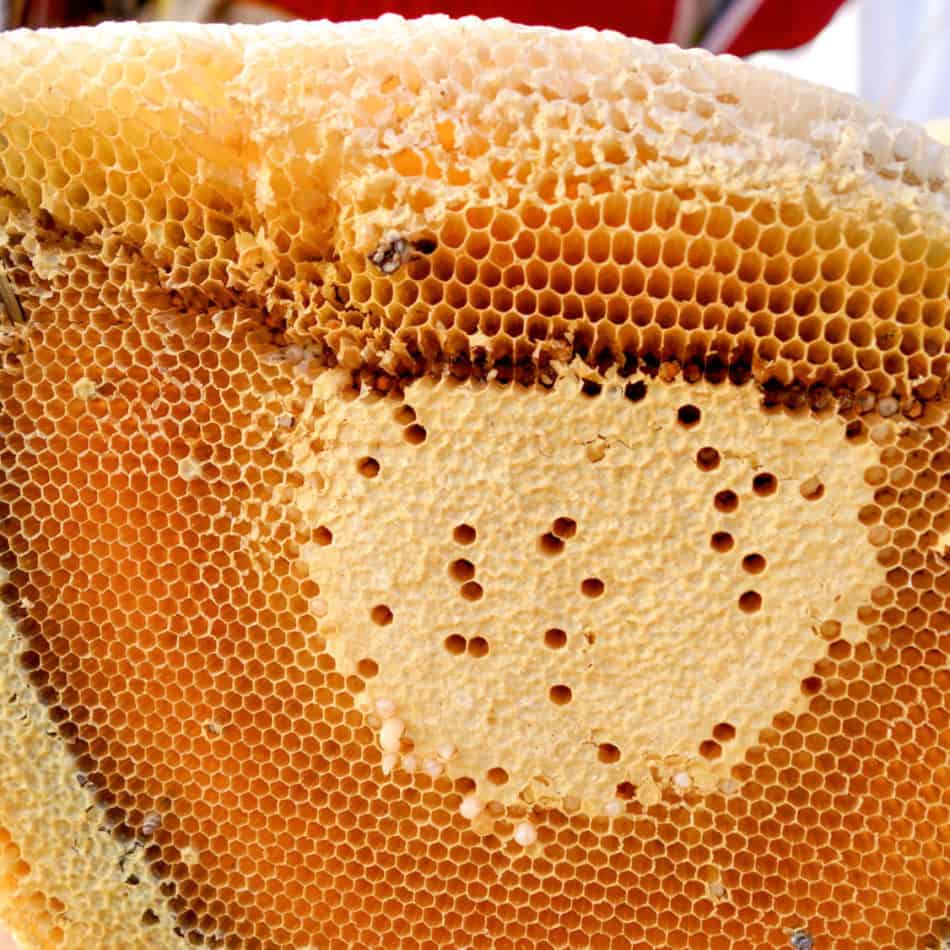
Like everything involving honeybees, when I ask a question of a more experienced beekeeper the answer usually begins with “that depends…”. Of course, the amount of time it takes for bees to harvest nectar and produce honey is exactly this type of question.
Honeybees can pretty much start making honey right away if they have a decent nectar source. But it takes a lot of bees to produce a significant amount of honey. Also, how quickly honeybees can make honey really depends on several important factors with the strength of the colony being the most important.
Strong Established Hives
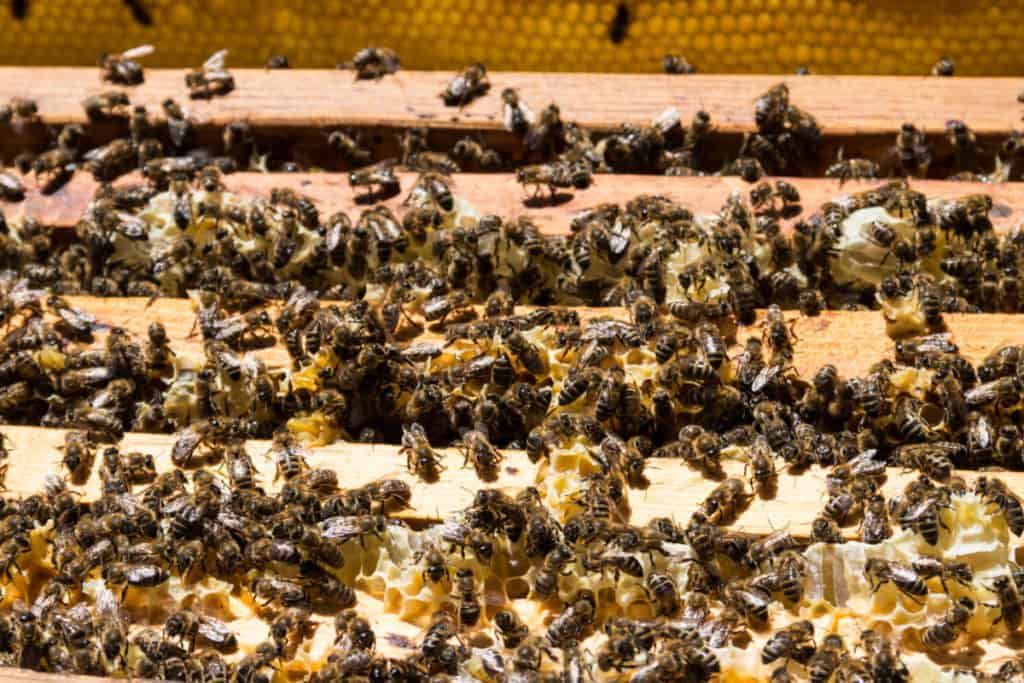
The strength of a bee colony will dictate how long it takes for bees to make honey and can only do so when there is nectar available. A strong established honeybee colony can produce a lot of honey very quickly.
During a heavy nectar or honey flow, a strong colony can fill a 10-frame deep honey super with honey in 2 to 3 days. Whereas a weaker but established colony may take 1-2 weeks to produce the same amount of honey.
To put this in perspective, the amount of honey produced is approximately 60 to 80 lbs., with the total weight of the deep honey super being around 90 to 100lbs.
Of course, how quickly bees can produce honey depends on the size of the bee population. Is the colony only a single brood nest or has it been expanded into 2-3 deep brood boxes? The larger the colony population is usually indicative of higher honey production, but not always.
And if you want more information about filling your honey supers, hold up for a bit, I wrote an article all about how long it takes bees to fill a honey super that I encourage you to read!
However, while it’s great to have exceptionally strong and established honeybee colonies, if there is no nectar flow, then there is no honey production. Some seasons will have poor weather conditions with very limited nectar flow and beekeepers end up having to supplement feed their bees to just keep them alive.
According to the Canadian Honey Council, some northern commercial beekeepers located in Alberta and Saskatchewan will regularly harvest over 300 lbs. of honey per colony. This is pretty impressive considering the honey flow season in these regions is substantially shorter than many southern climates.
Since honeybees only forage for approximately half of their life cycle, around 14 to 21 days during the summer months, it takes around 550 bees 2-3 weeks to produce one pound or 454 grams of honey.
These stats are based on the average amount of honey a bee produces in their lifetime which is 1/10th of a teaspoon or 0.8 grams (Canadian Honey Council bee facts).
And if you want some guidance on selling your honey, I also wrote an article all about how much money you can make selling your honey that I encourage you to read!
But most beekeepers have both strong, weak, and new bee colonies. So how do new or very weak colonies rank regarding overall honey production?
New Weaker Hives

Realistically a new honeybee colony will take between 3 to 5 months to begin producing excess honey. But the bees probably won’t produce enough honey for you to harvest their first season. New bee colonies usually need the first season to build up their strength and prepare to survive the winter.
How quickly a new colony becomes established will also depend on where you sourced your bees from. Did you purchase a package of bees or a nucleus colony? These are both weak colonies but at least with a NUC they’re working bees with some frames of brood and food stores and are in sync with a working queen.
Whereas with a package or box of bees they don’t have any frames, no drawn comb, no brood or food stores, and no queen. These bees are starting completely from scratch and require a lot of time, energy, and food stores to build up their hive. In addition, these bees must accept the queen you introduce and if they don’t you’ll have to requeen this colony.
To help you choose whether you want to buy packages of bees or nucleus colonies, I wrote all about the pros and cons of packages of bees vs nucs I encourage you to read!
Whether you purchased a NUC or box of bees they will need a lot of TLC. They will require supplemental feeding, sugar syrup and pollen patties, to help them build up their stores and provide enough energy to draw comb.
Also, mites are an issue with all bee colonies but especially newly purchased bees. You always need to test and treat for mites within a couple weeks of setting up your new bees. If left untreated your bees probably won’t survive the winter, and you’ll be back to square one.
But what about splits? If you have existing strong colonies, you will be splitting those off into new colonies and new queens (purchased or locally raised). Most experienced beekeepers don’t expect their splits to produce honey their first season.
Some splits will produce a small quantity of harvestable honey with the right conditions. But most beekeepers plan their splits to produce harvestable honey in their second season.
There is always the exception, if the weather is good, queen and hive are healthy, mites are low or nonexistent, brood is plentiful, pollen and nectar is strong, and the hive is productive then you may see enough excess honey to harvest your first year. But this is a pretty rare aligning of the stars.
But whether you purchase a box of bees, buy NUC’s, or do your own splits, these are weaker colonies which require time to build and become established. Consequently, these colonies are unlikely to produce enough honey to be harvested their first season.
How Long Does It Take Bees To Draw Comb
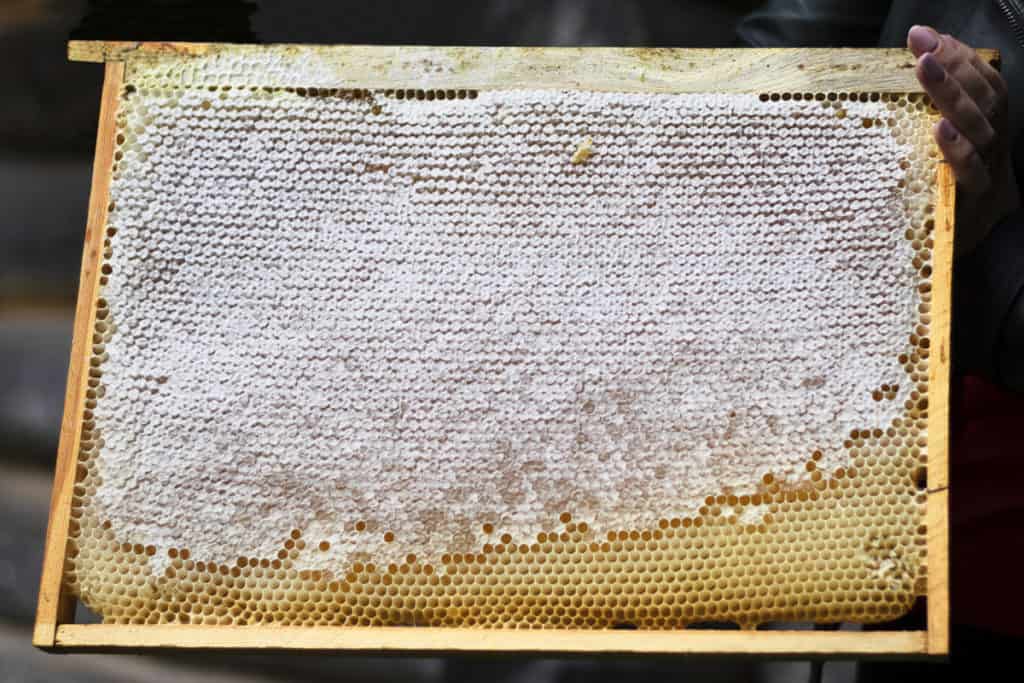
The time it takes to build comb will depend on the size of the honeycomb or frames (deeps, mediums, or shallows), the size of the bee population, and the amount of nectar available to the colony. Other factors are whether the bees were given starter frames with foundation, how strong is the colony, and are they receiving supplemental feeding.
Whether the colony is weak or strong if the beekeeper is giving them supplemental feeding, such as sugar syrup and pollen patties, these bees will draw comb far quicker.
This and the other factors listed above is why there is such a wide time frame when answering this question. Some colonies will draw out 10 frames in a deep box within 3 days, where some take 7 days, while others will take 2 months.
On average, stronger colonies will take 1 to 2 weeks to draw comb and in some cases even fill it with honey. Whereas weaker colonies will take 2 to 3 months to draw comb for producing brood and storing food and nectar.
This is based on the bees drawing out the frames in a 10-frame deep box. Also, it will take bees less time to draw out comb on mediums and especially shallows, and even quicker on 8 frame boxes.
Of course, bees require a large amount of nectar to produce comb. It takes around 40 pounds of nectar for bees to make 1 comb weighting 1lb. This is before they even begin to fill the cells with nectar and produce honey.
Since wax is the basis for honeycomb, bees will consume around 6-8 pounds of honey to produce only 1 pound of wax. Also, they require around 5 pounds of nectar to produce 1 pound of honey.
Well that’s enough fun bee facts for now and check out my post How long it does it take for bees to make honeycomb for a more in-depth answer.
What Months Do Bees Make Honey
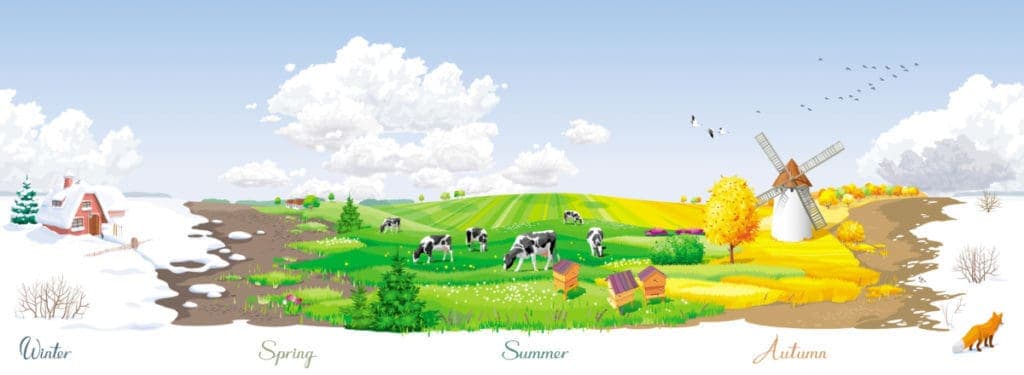
The most common months for honey production in the United States and Canada are normally from June to September. But this does vary by a few weeks or even months depending on specific regions, especially the more southern climates.
Since bees require a strong nectar flow to produce honey, they don’t normally make honey in the winter. Most regions don’t have local flora and plant life producing pollen and nectar during the winter months. But like everything there is always exceptions to these rules, in this case for some of the more southern climates.
Since honeybees don’t hibernate, and if the weather is warm enough during the winter months, bees will continue to forage. But, it’s always best to speak with local beekeepers and associations to find out the ideal pollen and nectar flows in your area.
Here are several examples of the ideal honey producing months for some regions in the US:
- Washington – June to August
- Colorado – April to October
- Southern US States – March to November
In Canada, the strong nectar flows are usually between the beginning of June until the end of August or the beginning of September. Like all regions this will vary from year to year depending on weather and temperature conditions.
For those of you in the UK, the Manchester & District Beekeepers Association have a breakdown of the common beekeeper’s year. It’s quite informative and can be found here: The Beekeepers Year. Their honey production is commonly from mid to late May until August.
As long as honeybees have a strong nectar flow, they’ll just keep foraging and storing nectar endlessly to grow their colony or in preparation for the winter.
Also check out my article all about the best time of year to start beehive colonies for further info on planning next years hives.
Why Do Bees Make So Much Honey
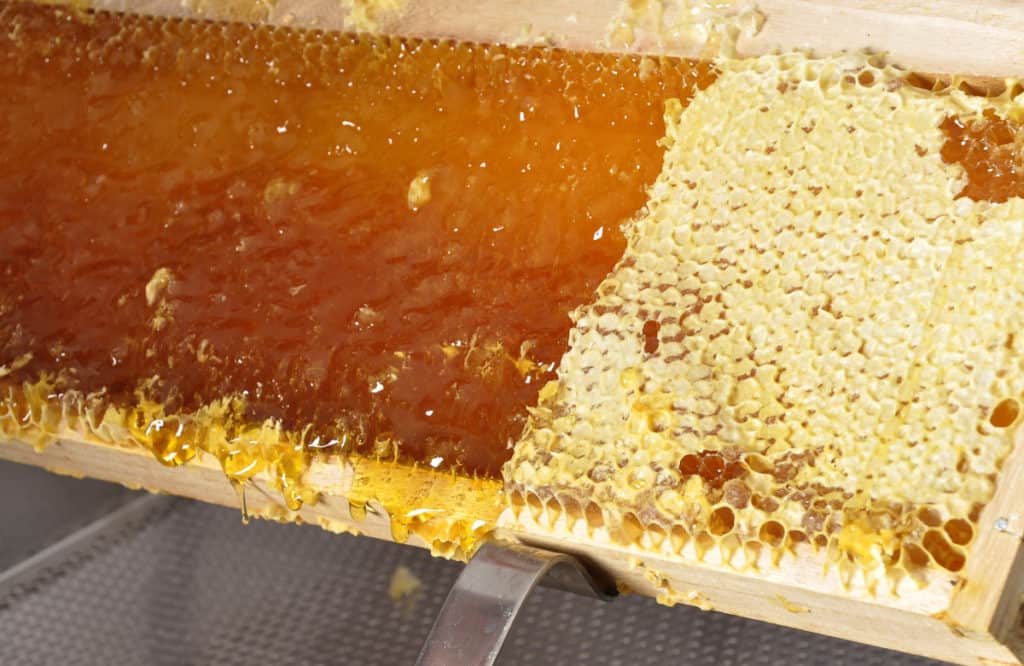
Honeybees require a lot of energy to build comb, expand their colony, and survive the winter months. This requires a ton of nectar to be gathered and turned into honey. Honeybees require this nectar and honey as fuel to give them then energy to perform these tasks.
Since honeybees don’t hibernate in the winter months, they require a lot of energy, honey, to survive the winter. The bees will form clusters around the brood frames and queen to regulate the temperature of the hive. This is the main reason why bees gather so much nectar and why robbing often occurs in the early fall.
Bees don’t know when to stop foraging, they will just keep collecting and storing away any available food stores, pollen, and nectar to be made into honey. Bees don’t know how much honey they are going to need to survive the winter, so they’ll just keep collecting as much as they can.
So, beekeepers take advantage of the bees crazy work ethic. Beekeepers will remove a honey super once filled with honey and replace it with an empty one. The bees believe they are low on honey stores and will just keep foraging and fill the new honey super. This practice will continue until the strong nectar flow is over.
Beekeepers will replace the filled honey supers with boxes of empty frames with existing comb already on them. This saves the bees a lot of energy and time since they don’t have to draw any comb. Thus, the bees only have to fill the frames with honey and will devote all of their time gathering nectar for honey production.
It’s also important to note that bees want to be working in sync with their queen. A happy colony of bees is a working colony of bees.
Lastly, most commercial and hobbyist beekeepers will feed their bee colonies sugar syrup in the fall so the bees can prepare for the winter months. This also discourages bees from robbing resources from neighboring colonies.
Related Questions
How many times a year do you harvest honey? Most beekeepers harvest honey 2-3 times per year/season. Honey is normally harvested between mid-June until mid-September. How often you harvest depends on your local climate and plant life. Poor weather conditions, disease and pests infiltrating your hives will also affect your harvesting schedule.
Can you keep bees without harvesting honey? You can keep honeybees without harvesting honey, but it’s not recommended due to several negative consequences. Your bees won’t have enough room to store excess honey, will become overpopulated, and then swarm. Swarming of unmaintained colonies increases the spread of disease and pests to other healthy colonies.
How long can you keep capped honey before extraction? You can store capped honey frames for two to three days at the most. But you need to ensure they are wrapped really, really, well to keep bugs and pests out and stored securely to keep away any hungry animals. Any longer than a couple of days and it is best to freeze your honey frames.
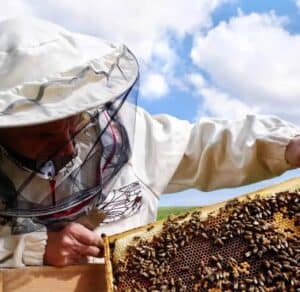
Joseph Davis
My goal is to show that anyone can take up beekeeping and it can be a very rewarding hobby. I strive to share my experiences and answer any questions you may have.
